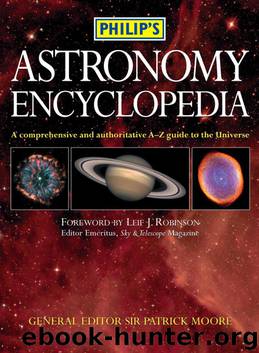Encyclopedia of Astronomy by Patrick Moore (editor)

Author:Patrick Moore (editor)
Language: eng
Format: epub
Published: 2011-01-13T08:26:09.421000+00:00
L AST ENCY PHI fin 11/4/02 6:41 pm Page 224
last contact
the galactic equator to the galactic poles. Heliocentric LEO (GEN. LEONIS, ABBR. LEO)
latitude is the same as celestial latitude, but corrected for a hypothetical observer located at the centre of the Sun, while heliographic latitude is measured on the Sun’s Large, distinctive northern constellation and one of the signs of the zodiac. It represents the Nemean lion killed by Hercules as the first of his twelve disk, north or south of its equator.
labours in Greek mythology, and lies between Cancer and Virgo. Leo is easily recognized by the asterism known as the SICKLE, a reversed question mark Lauchen, Georg Joachim von See RHAETICUS
formed by six of the constellation’s brightest stars, with the brightest of all, REGULUS, mag. 1.4, at its base.  Leo, DENEBOLA, marks the lion’s tail. ␥ Leo, launch window Period of time during which it is ALGEIBA, is a fine visual binary with orange and yellow components, mags. 2.5
possible to launch a particular space mission.
and 3.6, separation 4Љ.6, period about 600 years. The constellation also contains Wolf 359 (also known as CN Leo, a variable star of the UV CETI type, leap second Periodic adjustment by one second of range 11.5–17.1), the third-closest star to the Sun, just 7.8 l.y. away. Deep-sky COORDINATED UNIVERSAL TIME (UTC) to ensure that it objects in Leo include five 9th-magnitude spiral galaxies: M65 (NGC 3623), remains linked to the rotation of the Earth.
M66 (NGC 3627), M95 (NGC 3351), M96 (NGC 3368) and M105 (NGC
The braking action of the tides causes the Earth’s peri-3379), the first two and last three of which are grouped close together in the od of rotation to slow by between 1.5 and 2.0 milliseconds sky. Leo I (10th magnitude) and Leo II (12th magnitude) are a pair of dwarf per day per century. In order that time as kept by atomic spheroidal galaxies in the LOCAL GROUP, about 815,000 and 685,000 l.y. away, clocks (UTC) and that derived from observations of the respectively. The Leonid meteor shower radiates from the constellation.
stars (UT1, see UNIVERSAL TIME) do not differ by more than 0.9 seconds, an extra second is introduced to UTC at BRIGHTEST STARS
midnight on either December 31 or June 30 as required.
Name
RA
dec.
Visual
Absolute
Spectral
Distance
This has the effect of producing an accumulated dif-
h
m
º
Ј
mag.
mag.
type
(l.y.)
ference between UTC and INTERNATIONAL ATOMIC TIME
␣ Regulus
10 08
ϩ11 58
1.36
Ϫ0.5
B7
77
(TAI) of an integral number of seconds. The most recent
␥ Algeiba
10 20
ϩ19 51
2.01
Ϫ0.9
K0
126
leap seconds were inserted as follows:
 Denebola
11 49
ϩ14 34
2.14
1.9
A3
36
Date
TAI–UTC
␦ Zosma
11 14
ϩ20 31
2.56
1.3
A4
58
1989 December 31
ϩ25.0 sec
⑀
09 46
ϩ23 46
2.97
Ϫ1.5
G0
251
1990 December 31
ϩ26.0 sec
Chertan
11 14
ϩ15 26
3.33
Ϫ0.4
A2
178
1992 June 30
ϩ27.0 sec
Adhafera
10 17
ϩ23 25
3.43
Ϫ1.1
F0
260
1993 June 30
ϩ28.0 sec
10 07
ϩ16 46
3.48
Ϫ5.6
A0
2138
1994 June 30
ϩ29.0 sec
1995 December 31
ϩ30.0 sec
1997 June 30
ϩ31.0 sec
L
structed a 48-inch Newtonian on a fork mounting. Then, 1998 December 31
ϩ32.0 sec
having developed the most technically exact and versatile reflecting telescopes of the age (and published the details leap year Year containing 366 instead of the usual 365
of their construction), he spent over five years in Malta, days. The CALENDAR is based on a solar year of 365.
Download
This site does not store any files on its server. We only index and link to content provided by other sites. Please contact the content providers to delete copyright contents if any and email us, we'll remove relevant links or contents immediately.
Tools of Titans by Timothy Ferriss(8218)
Turbulence by E. J. Noyes(7936)
Secrets of Antigravity Propulsion: Tesla, UFOs, and Classified Aerospace Technology by Ph.D. Paul A. Laviolette(5309)
Astrophysics for People in a Hurry by Neil DeGrasse Tyson(5130)
Room 212 by Kate Stewart(5035)
Design of Trajectory Optimization Approach for Space Maneuver Vehicle Skip Entry Problems by Runqi Chai & Al Savvaris & Antonios Tsourdos & Senchun Chai(5011)
Pale Blue Dot by Carl Sagan(4912)
The David Icke Guide to the Global Conspiracy (and how to end it) by David Icke(4625)
A Journey Through Divination and Astronomy by Publishing Pottermore(4344)
Goodbye Paradise(3726)
Apollo 8 by Jeffrey Kluger(3637)
COSMOS by Carl Sagan(3554)
Losing the Nobel Prize by Brian Keating(3498)
The Five People You Meet in Heaven by Mitch Albom(3474)
How to Read Water: Clues and Patterns from Puddles to the Sea (Natural Navigation) by Tristan Gooley(3406)
Brief Answers to the Big Questions by Stephen Hawking(3369)
How to Read Nature by Tristan Gooley(3249)
The Order of Time by Carlo Rovelli(3145)
A Brief History of Time by Stephen Hawking(2960)
